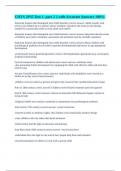Exam (elaborations)
CHYS 2P35 Test 1- part 2 || with Accurate Answers 100%.
- Course
- Institution
Important features that distinguish most child disorders correct answers -adults usually seek services for children & it is unclear whose "problem" should be the focus (is fam therapy needed? Is it parent that needs to work alone with child?) Important features that distinguish most child disord...
[Show more]



